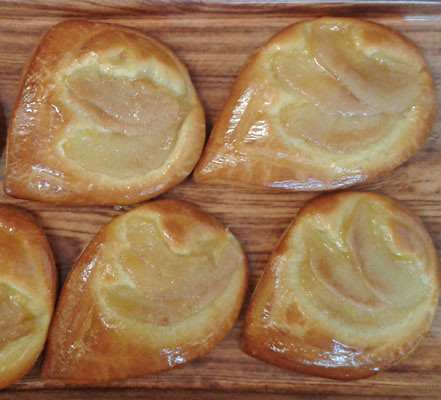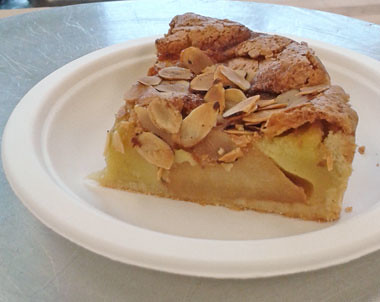
(That is fresh pear brioche), by breads:

(Sourdough, with oat porridge and almonds folded in), and tarts:

(Tarte Normande, big chunks of apple, and topped with sliced almond).
I made quite a few variations on what we call "three day breads." The technique for these is tuned to the rather unusual (for a bakery) hours we have to work on them. We're in the bakeshop from 9:00 a.m. until 1:30 p.m. each day, so we have to adjust rising and proofing times to suit, while still letting these breads develop the best flavors. The typical schedule is like this:
Day one:
Mix the preferment (sourdough-based starter) around noon, cover and leave out at room temperature overnight.
Day two:
Mix the preferment with the rest of the final dough ingredients except the salt (I do this by hand if I'm making the more-or-less standard 8 to 9 two-pound loaves). Cover the bowl and let it sit 30 minutes. This step is called "autolyse" and it lets the flour start to hydrate itself, and the enzymes in the flour a chance to start breaking down starches and proteins.
Then mix in the salt and put the dough in an oiled bin.
For the next 3 hours, fold the dough every 30 minutes. "Folding" means lifting the dough on one side and folding it over the main dough, then lifting the opposite side and folding over, then ditto for the two other sides. The folding serves the purpose of kneading and punching that you probably have seen in ordinary household bread recipes. It's wonderful to see how the dough develops between each fold, getting more lively, smoother, and developing that lovely sourdough smell.
After completing the folds, scale (cut the dough and weigh it in equal amounts - for us it's usually two pounds) and preshape the loaves. Often the preshape is a "loose boule" (soft round ball) but not always - the preshape depends on what you want your final shape to be. Let the preshaped loaves rest on a floured surface (bread board) for 15 minutes.
Do the final shaping of choice for the loaves, and put them in floured banettons (plastic bowls) or cloth-lined baskets. Retard (chill) overnight. We have a proof box that can have its temperature adjusted for either a warm or cool rise. A home baker equivalent would be to put the loaf in the fridge overnight. It will continue to develop but at a very slow pace.
Day three:
Take loaves out of the retarder and let them warm to room temperature - about an hour and a half. The loaves will revive and start to raise. When they are ready, turn the out of the baskets or banettons, slash them (this lets the crust open nicely when baking), and bake.
For you home-bakers, here is an excellent video showing how to use this same method for home bakers. It's from an Irish bakeshop and bread school called Riot Rye, whose mission is to empower people to make home-baked bread.
OK, that's the end of today's lesson! Next post I will explain the relevance of flowcharts to Pastry. Really!
Tarte Normande looks wonderful! Perhaps you'll make it again someday. 8~)#
ReplyDeleteThat recipe would probably be really good (and more colorful) with our Liberty apples. Something to try this October.
DeleteReading this blog always makes me hungry. And what's this about flowcharts! Thought you were done with all that ;-)
ReplyDelete